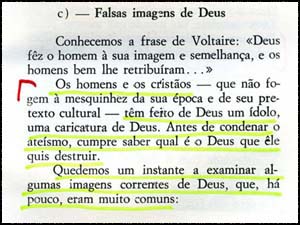In the late 1960s one of extravagances that appeared as a consequence of Vatican II's adaptation to the Modern World was the so-called Theology of the Death of God. This current defended that Atheism had been correct in its criticism of God because the God conceived by the Catholic Faith was a caricature of God, which in fact should be wiped off the horizon.
The "true God," according to them, would be a divinity conceived as an energy present everywhere in an evolving universe, and therefore also inside each man. Such an energy would be in a continuous process of evolution from creatures and material things to increasingly noble stages. It is, therefore, an immanent god that is not essentially different from the universe. Hence the role of "Religion" would be to help make man aware of this energy present inside his soul and faciliate the evolving process. Obviously, this god and this religion do not clash with Atheism, whose ultimate purpose is to attack the one, true, trancendent God as taught by the Catholic Faith.
Today that theological current has practically disappeared under the name of Theology of the Death of God. But its ideas have spread everywhere in the Conciliar Church, even to its highest echelons.
Among the advocates of this denial of God, one can find the principal Moderator of Vatican II: Cardinal Leo Suenens. In his article Christianity without God, published in the book Christianity without Christ, he affirms that the traditional image of God should disappear.
At right top is pictured the cover of Cristianismo sem Cristo?; at right, photocopies of the Portuguese text. At left below, we present our translation of the lines highlighted in yellow.
Men and Christians .... have made an idol of God, a caricature of God. Before condemning Atheism, it serves to know what is the God that it wants to destroy.
Let us take a moment to examine some of the current images of God, which were very common a short time ago ....
That God which is found in the beginning as an architect and engineer in repose, like one who explains and covers the ignorance and incapacity of man is also the one that presently guarantees the established order, the status quo, who shields authority with divine right and protects the strong against revolutions, who requires patience from the poor, who impedes social reforms: He is the opium of the people.
We can analyze diverse caricatures of God. To mention just one: let us think of the caricature of the God as Providence who "providentially" allowed us to avoid some misfortune, but who permitted the same misfortune to happen to someone else. It is a type of second-rate providence ....
It is really understandable that this God should die so that the world lives, and also so that God lives.
(Leo-Josef Suenens, "Cristinaismo sem Deus," in Cristianismo sem Cristo?, Caxias: Edições Paulinas, 1970, pp. 63-66).
|




 |
